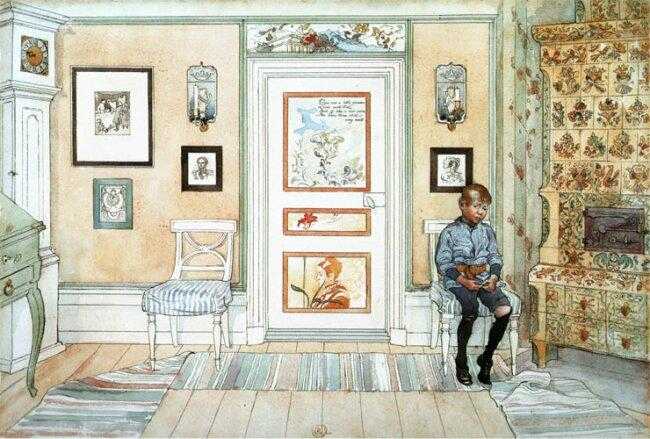
Artists Illustrating Swedish Boys' Fashions: Karl Larsson --Paintings

Figure 1.-- This Larsson painting is called "In the Punishment Corner" and shows a boy being made to sit alone in a Swedish room by himself to contemplate his misbehavior. The boy wears typical Swedish middle-class clothes of the period when the picture was conceived (about 1910 probably). The boy wears a blue outfit with knee
pants and one of his black stockings detached from its garter and falling down over one knee. The dischevelled clothing nicely renders the boy's unhappiness. As does painting him a small figure in a large room. The interior of the Swedish room with its quaint decor and fireplace remind one of the scenes from Bergman's great film, "Fanny and Alexander" set in the same period in Sweden.
|
|
While we can admire Larsson's work, we in fact know little about the individual portraits that we have collected by him. He presents us with a wide range of children in many different outfits. We do not know who these children were. Hopefully our Swedish readers can tell us more about Larsson and his paintings. While we do not know anything about the children, Larsson provides us a wonderful record of children's lives and how they were dressed. And unlike the black-and-white photography of the day, Larsson provides us colorful images which tell us a great deal about the color of the garments the children wore.
Dresses
Larsson painted many younger children, including boys that were not yet breeched.
Tunic Outfits
Some children seem to be wearing belted tunics. One the previous page a boy wears a lace collar and red long stockings. We do not lnow, however who the boy is. We would guess that he comes from a prosperous middle-class urban family. Tunics were at times fashionble boys wear. They were very commonlywirn by boys in many European countries. The tunics that Larsson paints, however, seem more Swedish folkwear than fashionable European dress.
Many boys in the late-19th and early 20th century wore blouses. During the summer or warmer months they were worn without jackets. These blouses were usually worn with knee pants and long stockings. This is commonly seen in the photographic record. The blouses were often white, bit there were many colored blouses as well as patterns, especially stripes. The photographic record of course was black and white. Thus we do not know what colors were involved. Artists like Larsson provide some insights as to the colors involved.
Sweater
The boy in the paunting herevlooks to be wering a front-buttobing sweater,but it a a little difficicult to tell (figure 1). I think it is a front-buttoning sweater. Notice the belt he wears over it.
Knee Pants
Larson depicted some younger boys not yet breeched. Most of the other boys he depifts wearing knee pants. Knee pants were very popular for boys, espcially in the late-19th century and early 20th century. Most boys wore them.
We also note a wonderful country scene with a mother anf her children. He daughter swears a pinafore, very common at the time. The boys, however, seem to be wearing caps and tunics which seemed influenced by folk costume. It is interesting that the boys wear these folk -like costumes while mother and her daughter do not. In much of Europe, it was more common for women and girls to wear folk costmes than boys. Here an exception may be Germany. One of the boys is barefoot while the other wears stripped long stockings and unusually short shoirt pants for the timne. I'm not sure when the painyting was dine, but I would guess the 1890s.
Hosiery
Many of the children Larsson paints are shown wearing long stockijgs. Both boys and girls wore them, especially in the late-19th and early-20th century. We note colorful stockings, striped stockings and black stockings. Black stockings were especially common around the turn-of-the 20th century. Long stockings were worn in America and throughout Europe. They were very common in northern countries like Sweden with harsh climates. Larsson often depocts them flling down as a kind of badge of childhood. Europeans did not as commonly wearing the stocjing supporters worn by American children. Interwstingly this decice was picked up for the most famous Swedish child character--Pipi Longstockings. Almost certainly Larsson was the inspiration.
HBC

Navigate the Boys' Historical Clothing artistic pages:
[Return to the Main Larsson art page]
[Return to the Main Swedish art page]
[Return to the Main artistic page]
[Chronologies]
[Individuals]
[National]
[Styles]
Navigate the Boys' Historical Clothing Web Site:
[Return to the Main Swedish page]
[Return to the Main ethnic page]
[Introduction]
[Activities]
[Biographies]
[Chronology]
[Clothing styles]
[Countries]
[Bibliographies]
[Contributions]
[FAQs]
[Glossaries]
[Images]
[Links]
[Registration]
[Tools]
[Boys' Clothing Home]
Created: 5:19 AM 3/22/2009
Last updated: 8:25 PM 3/26/2009



